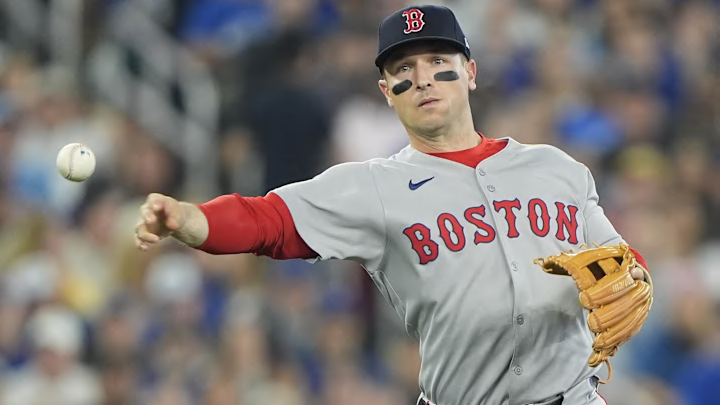The 2025 Boston Red Sox had fielded their finest quartet around the diamond since at least 2022, despite both first and second base providing replacement-level production. The 2026 Red Sox are currently projected to have an even more troublesome alignment, with first, second, and third all open to contention.
Right now, the Red Sox have the best and deepest outfield in the majors, a pitching staff with both an ace and depth, and one of the greatest closers of all time coming off the finest season of his illustrious career. If the Red Sox intend to take another step forward, then they must establish an infield worthy of such ambitions.
First Base: Casas’ Health Creates Questions
For the past three seasons, the Red Sox have entered the season with Triston Casas, the starter at the cold corner. In each of the three, Casas missed time due to injury, first a month, then half a season, and finally almost all of the latest. When available, the imposing slugger has produced with the bat and shown improvement on defense, but his durability means Boston requires a strong understudy at minimum.
In 2025, manager Alex Cora made a virtue of Romy Gonzalez and Abraham Toro for most of the summer, before the acquisition of Nathaniel Lowe provided much-needed offensive support from the left side. Gonzalez responded with a career year, smashing southpaws while holding his own against right-handers for the first time.
History has shown Casas will not last the full rigors of a 162-game season, but depending on Gonzalez to replicate his 2025 level would be foolhardy at best. Within the organization, only one other plausible candidate exists, as former prodigy Kristian Campbell received action at the spot in August and September with Worcester.
Second Base: The Long-Standing Quandary
As previously noted, second base has stood as a black hole since the fall of Dustin Pedroia. Boston’s most recent attempt at a long-term solution in Campbell struggled to adapt with the bat at the major league level and displayed the glovework of a challenged first baseman. Thus, for a second consecutive year, center fielder Ceddanne Rafaela was dragooned into filling the middle infield’s vacancy, a necessity the team will no doubt wish to avoid for a third go-round.
Similarly inexpedient, David Hamilton spent the most time in 2025, displaying his usual speed and defense that make him such a valuable role player off the bench, as well as his anemic bat. With Campbell discredited, second base remains as open as ever. Internal options such as Nick Sogard are no longer plausible solutions in either the long-term or even for a single season; Boston’s best second baseman is Romy Gonzalez, who is already due significant time at first, further heightening the importance of Casas’ health.
Third Base: A Self-Inflicted Error
Alex Bregman’s impending departure makes its strongest waves here. After his single season in Boston, which ultimately cost the team the services of its best hitter in Rafael Devers, what recently seemed one of the deepest allocations of talent in baseball has become a glaring hole. It is doubly important that a solution be found to avoid recrimination and relitigating the Devers drama.
Chief Baseball Officer Craig Breslow should already possess some notion, given Bregman spent much of the summer on the injured list. Top prospect Marcelo Mayer debuted and acquitted himself well with the glove during that time; his bat showed signs of needing further refinement, and Mayer shares Casas’s questionable durability.
This winter’s free agent market provides only Eugenio Suarez as an acceptable replacement for Bregman, and Suarez is weaker on both sides of the ball, as well as being two years older.
Shortstop: Decline Inevitable
Trevor Story had a bounce-back year after several seasons plagued by injury. His post-May line of .289/.334/.492 matches well with career norms, and his base-running ability remained as sharp as ever. On the other hand, Story is entering his age-33 season and just posted the worst defensive numbers of his career.
While shortstop remains his to lose, it seems highly unlikely he lasts at the position beyond 2026. Still, that doesn't change the fact that the Red Sox need Story to replicate his latest performance to give them their best shot at back-to-back postseason appearances.
Red Sox's 2026 Success Will Depend on Infield
Having received poor offense from two of four spots in 2025, the Red Sox may yet face even worse production on both sides of the ball in 2026 at each position. First and third may be placed in the hands of rookies, while the extent of Story’s inevitable decline will determine if he remains capable of holding down short. Second base remains in flux as ever.
To some degree, finding the answer at one spot will necessarily simplify matters at another; if Casas or Campbell takes over at first, second can then be granted to Romy Gonzalez on a more permanent footing. Conversely, if Story needs to be moved to second, then Mayer will likely slide into short, leaving third base even more unstable.
With an outfield of at least four solid defensive players, three of whom are above-average hitters, and the organization’s finest all-around catcher since Jason Varitek in place, solving the infield questions will turn the Red Sox lineup into one of the best in baseball. Hopefully, it happens sooner rather than later.
